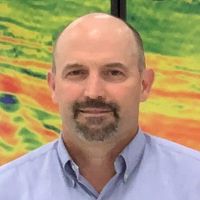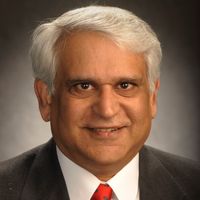
Podcast Interview: Doug Kothe discusses many aspects of the ECP, from the project’s inception to its enduring legacy and its impact on industry and workforce development.

We’re trying to mesh health data together and make sense out of it, and that’s a huge challenge. That’s where exascale computing infrastructure, such as Frontier, will be the paradigm shift, because we can bring all of the data together and analyze it in a time efficient way. Imagine having a computational framework that allows us to model an individual’s life trajectory based on their genomic information, and any ancillary information we have about that individual. We could then track that individual throughout their lifetime, and guide them to make informed decisions about their future, taking control of their future before a problem emerges. It’s not the lifespan, it’s the healthspan that matters to all of us.
Gina Tourassi, ORNL (future home of Frontier)
Director for the National Center for Computational Sciences

This is not a destination as much as it’s a journey, and exascale is the next waypoint on this journey for ever-increasingly more powerful computers. With exascale, we’re going to have smarter AI and we’ll have higher resolution simulations, and it will impact nearly every technology-oriented problem we have, whether it’s climate, fluid dynamics, biology, materials or chemistry. All of this is going to get both a boost from the core compute in exascale, and then an extra boost from applying machine learning, opening up many possible paths for future deployment as well.
Rick Stevens, ANL (future home of Aurora)
Associate Laboratory Director
Computing, Environment and Life Sciences

The confluence of exascale computing and artificial intelligence will have a transformative impact on all of science. From discovery and design of new drugs to innovative materials and medical treatments, to quantum leaps in our ability to simulate largescale physical phenomena with microscopic high fidelity and accuracy—the impacts of our simulation capabilities will go far beyond anything we have experienced to date.
Chris Clouse, LLNL (future home of El Capitan)
Program Director
Weapon Simulation and Computing
Entering a new era in scientific discovery
Exascale computing will transform the ability to answer some of the world’s toughest and most important questions

Katie Antypas
Lawrence Berkeley National Laboratory
One of the most exciting steps forward ECP is bringing to HPC facilities is a set of applications with new capabilities, a new software ecosystem, and new means for deploying and maintaining software on next-generation computing systems. These...
One of the most exciting steps forward ECP is bringing to HPC facilities is a set of applications with new capabilities, a new software ecosystem, and new means for deploying and maintaining software on next-generation computing systems. These advances encapsulate the community’s brain power and computational science knowledge and will live on longer than any individual system.

Rick Arthur
Senior Director of Computational Methods Research
GE Research
The marvel of Exascale computing resulted from decades of sustained exponential breakthroughs in hardware and software technologies, and now shapes computational modeling into a foundational instrument for scientific insights – as essential as a...
The marvel of Exascale computing resulted from decades of sustained exponential breakthroughs in hardware and software technologies, and now shapes computational modeling into a foundational instrument for scientific insights – as essential as a telescope to explore the heavens. In pursuit of such noble aspirations as a zero-carbon future, Exascale systems will be indispensable tools for GE engineers working at the cutting edge to ‘Build a World that Works’.

Franck Cappello
Argonne National Laboratory
Advanced multi-level asynchronous checkpointing and lossy compression software technologies have the potential to accelerate exascale applications executions. To deliver this potential, software technology developers need to produce effective,...
Advanced multi-level asynchronous checkpointing and lossy compression software technologies have the potential to accelerate exascale applications executions. To deliver this potential, software technology developers need to produce effective, reliable and sustainable software responding to user needs in addressing exascale computing challenges. The unique synergy at the core or ECP between users, applications developers, software technologies developers and vendors of exascale supercomputers accelerates R&D and provides the required framework for the development of robust production level software.

Sunita Chandrasekaran
University of Delaware
Exascale computing gives us tremendous opportunities to make scientific advancements in plasma physics that were utterly beyond our reach before. Also, it allows us to do more simulations. So instead of doing a single simulation once, we can play...
Exascale computing gives us tremendous opportunities to make scientific advancements in plasma physics that were utterly beyond our reach before. Also, it allows us to do more simulations. So instead of doing a single simulation once, we can play with the problem and find out which physics conditions work best. For tumor therapy this means we can discover new, innovative ways to improve the energy, quality, and precision of proton beams.

Steve Conway
Senior advisor for HPC market dynamics
Hyperion Research
Over time, technologies developed in government-funded exascale initiatives will benefit not just leadership-class supercomputers but will be scaled down economically to benefit the entire HPC market, including sites that acquire only a rack or two...
Over time, technologies developed in government-funded exascale initiatives will benefit not just leadership-class supercomputers but will be scaled down economically to benefit the entire HPC market, including sites that acquire only a rack or two of HPC servers. Because Global2000 companies increasingly use HPC to address challenging business problems, exascale innovations will also make their way into enterprise IT data centers. Some innovations will eventually be adapted for use in personal computing devices and other consumer electronics.

Bronis de Supinski
Chief Technology Officer, Livermore Computing
Lawrence Livermore National Laboratory
Exascale systems will be transformative. The impact that they will have on DOE's scientific missions, from climate science to particle physics to national security, is well documented. Even more exciting is the impact the rapid increase in capability...
Exascale systems will be transformative. The impact that they will have on DOE's scientific missions, from climate science to particle physics to national security, is well documented. Even more exciting is the impact the rapid increase in capability will have on our everyday lives, whether by enabling AI paired with physical models to support the development of clean energy technology, or in areas as diverse as self-driving vehicles to the automated analysis of great works of art and literature.

Jack Dongarra
University of Tennessee, Knoxville
The whole reason for exascale computing is because of the science. To advance science, you need exascale computing. I like to think of the exascale computer as a very sophisticated scientific tool. These exascale computing tools will be used to...
The whole reason for exascale computing is because of the science. To advance science, you need exascale computing. I like to think of the exascale computer as a very sophisticated scientific tool. These exascale computing tools will be used to understand something that we couldn’t understand before, so it allows us to push back those frontiers of science.

Thomas Ebbott
Goodyear
NASA Engineers Ahmed Noor and John Tanner once wrote, “The pneumatic tire represents one of the most formidable challenges in structural design,” and this still remains the case today. Often, tire simulations require multiphysics,...
NASA Engineers Ahmed Noor and John Tanner once wrote, “The pneumatic tire represents one of the most formidable challenges in structural design,” and this still remains the case today. Often, tire simulations require multiphysics, thermal-mechanical and fluid-structure interaction analysis with some solutions taking weeks with hundreds or thousands of processors devoted to the task. Exascale technology can be a game-changer for tires and for the automotive industry overall. Even today, we are seeing major advantages of using GPUs for certain simulations, and we look forward to deploying the advancements pioneered in the ECP to make complex and accurate tire/vehicle simulations viable in the virtual product development process.

Markus Eisenbach
Oak Ridge National Laboratory
Frontier is not only a quantitative improvement but a qualitative improvement in the physics that we can incorporate. Going to more powerful architectures and more powerful machines not only gives us the quantitative improvements due to the size of...
Frontier is not only a quantitative improvement but a qualitative improvement in the physics that we can incorporate. Going to more powerful architectures and more powerful machines not only gives us the quantitative improvements due to the size of the systems that we study, but also the possibility to implement less restrictive approximations and to expand the type of physical phenomenon that are accessible to us.

Charlie Fazzino
ExxonMobil
Oil and gas exploration gets increasingly more challenging every day as sophisticated and well-funded firms battle it out for the next big discovery. We’re tackling massive data sets, intense parallel computation, and thoughtful, creative...
Oil and gas exploration gets increasingly more challenging every day as sophisticated and well-funded firms battle it out for the next big discovery. We’re tackling massive data sets, intense parallel computation, and thoughtful, creative application of game-changing software—all at an ever-accelerating pace. The Exascale Computing Project is very familiar with these challenges and is well-positioned to support the future of O&G exploration. Through disciplined application of this technology, we feel confident in our ability to take on society’s dual challenge of providing reliable and affordable energy while advancing innovative solutions for a lower-carbon energy future.”

Salman Habib
Argonne National Laboratory
Exascale will enable cosmology simulations large enough to model the distribution of billions of galaxies but also fine-grained enough to compare to a range of ground- and satellite-based observations, such as cosmic microwave background measurements...
Exascale will enable cosmology simulations large enough to model the distribution of billions of galaxies but also fine-grained enough to compare to a range of ground- and satellite-based observations, such as cosmic microwave background measurements and radio, optical, and xray data sets. At the same time, Frontier’s AI-oriented technology will enable us to analyze data from simulations in ways we simply can’t today.

Morten Hjorth-Jensen
University of Oslo and Michigan State University
Understanding the limits of stability of the calcium isotope is something we can do in the immediate future with Frontier.

Robert Hormuth
Corporate Vice President, Architecture and Strategy, Data Center and Embedded Solutions Group
AMD
We will soon cross a momentous milestone with exascale computing that is many years in the making. Computing performance trends through the years have shown the steady increase, but we have also had to drive towards scaling performance while...
We will soon cross a momentous milestone with exascale computing that is many years in the making. Computing performance trends through the years have shown the steady increase, but we have also had to drive towards scaling performance while dramatically improving power efficiencies. This has required much broader incorporation of heterogeneous computing resources, incorporation of faster and better interconnect technologies, and the range of software that goes with it. AMD, with our partners, are on the verge of deploying the first exascale system in the United States, and it’s been massive effort that’s been a joy to watch unfold.

Phil Jones
Los Alamos National Laboratory
Exascale computing provides the additional capability needed to provide more accurate and robust projections of future climate change and actionable information as we move into an uncertain climate future. It is another step forward in our goal of...
Exascale computing provides the additional capability needed to provide more accurate and robust projections of future climate change and actionable information as we move into an uncertain climate future. It is another step forward in our goal of achieving cloud-resolving simulations of the climate system.

Paul Kent
Oak Ridge National Laboratory
Exascale systems like Frontier will allow us to make more confident predictions, study more complex materials, or look at materials made of elements from a wider range of the periodic table.

Raja Koduri
Senior Vice President and General Manager
Accelerated Computing Systems and Graphics (AXG)
Computing on the scale of the human brain -- something that was once only dreamed of in science fiction -- is now possible! We should all pause to celebrate the phenomenal work done to bring Exascale within reach, and then we should get back to work...
Computing on the scale of the human brain -- something that was once only dreamed of in science fiction -- is now possible! We should all pause to celebrate the phenomenal work done to bring Exascale within reach, and then we should get back to work to make this computing performance (and the next orders of magnitude) accessible to all to help solve humankind’s most pressing challenges.

Doug Kothe
ECP Director
Oak Ridge National Laboratory
While high-performance computing technology has evolved tremendously just during the life of the Exascale Computing Project [ECP], our project “team of teams”—composed of more than 1,000 researchers and scientists from across the United...
While high-performance computing technology has evolved tremendously just during the life of the Exascale Computing Project [ECP], our project “team of teams”—composed of more than 1,000 researchers and scientists from across the United States—works not only with a sense of urgency but also with agility and a firm focus on mission. Achieving success requires that we adapt to newer technology advances, tackle an array of technical challenges, and implement new approaches for complex collaborative project management. We remain unrelenting in the pursuit of our ultimate objective—the effective co-design and co-dependency of applications, software, and hardware at unprecedented scale to form a robust, capable ‘used and useful’ exascale computing ecosystem. Such an ecosystem will be a foundational step in technology’s nonstop march to contribute to the improvement of the human condition. We are confident that ECP will occupy a unique place in history and will leave a legacy of tools, technologies, solutions, and perhaps most important—people—that will be impactful for decades. The project’s overarching heritage will be the remarkable magnitude of collaborative and integrative effort it brought to bear in accelerating the crossing of a computing threshold that will open new pathways of discovery and provide breakthrough solutions.

Andreas Kronfeld
Fermilab
Exascale is getting exciting! Frontier is around the corner, and Aurora will follow soon. They will enable us to understand the strong nuclear force with unprecedented precision, allowing us to illuminate phenomena from high-energy collisions to...
Exascale is getting exciting! Frontier is around the corner, and Aurora will follow soon. They will enable us to understand the strong nuclear force with unprecedented precision, allowing us to illuminate phenomena from high-energy collisions to neutrino scattering to nuclear structure. Together with a wide range of experiments in high-energy physics and nuclear physics, humankind will understand the fundamental interactions of matter as never before.

Sherry Li
Senior Scientist
Lawrence Berkeley National Laboratory
As numerical linear algebra algorithm and software developers, we are inspired by exascale to redesign the algorithms with the newest capabilities – far beyond what were available six years ago. Accessible from our math libraries, these...
As numerical linear algebra algorithm and software developers, we are inspired by exascale to redesign the algorithms with the newest capabilities – far beyond what were available six years ago. Accessible from our math libraries, these capabilities enable scientists and engineers to vastly improve their understandings of myriad physical phenomena, with unprecedented high-fidelity simulations and thorough analysis of a tremendous amount of data.

Brad McCredie
Corporate Vice President, Accelerated Solutions Computing, Data Center Embedded Solutions Group
AMD
It is truly an exciting time to be in supercomputing and we are thrilled to be part of the march towards the exascale computing era. Creating and deploying solutions of this magnitude is itself, a grand challenge, but it represents a significant...
It is truly an exciting time to be in supercomputing and we are thrilled to be part of the march towards the exascale computing era. Creating and deploying solutions of this magnitude is itself, a grand challenge, but it represents a significant milestone in the capabilities for scientific computing. I am excited to see how the researchers and scientists using exascale systems will help improve the quality of life for people around the world and make new discoveries with this enhanced level of compute.

James Edward McClure
Virginia Polytechnic Institute and State University
Each time we get access to a new generation of supercomputer, we’re able to solve problems that we weren’t able to on the previous generation. One of the things that I’ve always enjoyed about doing this kind of work is you really have the...
Each time we get access to a new generation of supercomputer, we’re able to solve problems that we weren’t able to on the previous generation. One of the things that I’ve always enjoyed about doing this kind of work is you really have the opportunity to look for problems that the next generation architecture will allow you to solve that you couldn’t before. On Frontier, we can get at some of the more fundamental mechanisms that would have been harder to simulate in a realistic system.

Piyush Mehrotra
Chief, NASA Advanced Supercomputing Division
NASA Ames Research Center
NASA’s vision of the massive expansion in scientific and engineering knowledge to be achieved one day through exascale systems is truly exciting. Computational requirements for NASA applications such as coupled global atmosphere-ocean modeling,...
NASA’s vision of the massive expansion in scientific and engineering knowledge to be achieved one day through exascale systems is truly exciting. Computational requirements for NASA applications such as coupled global atmosphere-ocean modeling, simulation of galaxy formation, launch abort vehicle analysis, and retropropulsion for Mars entry, descent, and landing are inexorably leading toward a need for exascale computing resources, as scientists and engineers deal with the demand for higher fidelity results and faster turnaround time. In order to meet these needs, we are exploring new algorithms and code development approaches to effectively exploit the underlying heterogeneous architectural features of exascale systems in the coming years.

Jeff Nichols
Associate Laboratory Director
Computing and Computational Sciences
The architecture we put on the floor with Frontier is as equally capable at solving a big modeling and simulation program as it is at solving a big artificial intelligence program. Today with traditional modeling and simulation you can predict all...
The architecture we put on the floor with Frontier is as equally capable at solving a big modeling and simulation program as it is at solving a big artificial intelligence program. Today with traditional modeling and simulation you can predict all kinds of physical phenomena that you see in the world around you: climate change, the path of hurricanes, new materials for more lightweight cars. You can build models from first principles equations, and you can solve them to high accuracy. But now, with machines like Frontier, you can build models from data . . . allowing us to use artificial intelligence to actually interrogate and inquire within those models and find predictive capabilities.

Irene Qualters
Associate Laboratory Director
Los Alamos National Laboratory
ECP is giving us the tools to address some of the nation’s most complex scientific and security challenges. As we enter an era of continued technology innovation and disruption, our computational multiphysics models and software tools have matured...
ECP is giving us the tools to address some of the nation’s most complex scientific and security challenges. As we enter an era of continued technology innovation and disruption, our computational multiphysics models and software tools have matured to a robust foundation that is agile, robust, reliable and community-based. ECP sets a path to tackle the ever more challenging future in energy, climate, materials, chemistry, biology, and physics.

Andreas Roelofs
Raytheon Technologies Research Center Director
Leadership Class Computing has helped Raytheon Technologies accelerate technology development and bring more sustainable products to market. The Exascale Computing Project represents a major step forward and we are excited about the benefits this...
Leadership Class Computing has helped Raytheon Technologies accelerate technology development and bring more sustainable products to market. The Exascale Computing Project represents a major step forward and we are excited about the benefits this project will bring to industry competitiveness, our customers, and people around the world.

Evan Schneider
University of Pittsburgh
Using our Cholla astrophysics software on an exascale machine, we will be able to run a simulation where we can directly resolve what’s happening in small patches of the galaxy. So instead of having to make assumptions about how the stars are...
Using our Cholla astrophysics software on an exascale machine, we will be able to run a simulation where we can directly resolve what’s happening in small patches of the galaxy. So instead of having to make assumptions about how the stars are forming and how the supernovae are affecting the galaxy, we can actually just directly simulate that using the physics that we understand. There’s no other computer that’s big enough and has enough computing power to get the resolution that we require.

Sanjiv Shah
Vice President of Developer Software
Intel Corporation
I’m excited to see oneAPI usher in a new era of accelerated programming that will help Exascale computing tackle our greatest challenges. Already, oneAPI-accelerated AI is fueling everything from MLPerf submissions to the fastest supercomputer in...
I’m excited to see oneAPI usher in a new era of accelerated programming that will help Exascale computing tackle our greatest challenges. Already, oneAPI-accelerated AI is fueling everything from MLPerf submissions to the fastest supercomputer in the world – Fugaku. Native oneAPI implementations are emerging, targeting Nvidia, AMD GPU, ARM and ASIC platforms, like the Huawei Ascend AI chip. SYCL performance achieves >95% of CUDA on the same Nvidia GPUs with minimal code changes. The open, standards-based, and cross-platform accelerator programming model the industry is quickly adopting today will drive Exascale applications in the future.

Galen Shipman
Los Alamos National Laboratory
The Exascale Computing Project has brought together experts spanning computational science, computer science, applied mathematics, and software engineering to address one of the most challenging goals in scientific computing: delivering an integrated...
The Exascale Computing Project has brought together experts spanning computational science, computer science, applied mathematics, and software engineering to address one of the most challenging goals in scientific computing: delivering an integrated set of tools and techniques that enable exascale computing to tackle some of our most pressing needs in national security and scientific discovery.

Addison Snell
CEO
Intersect360 Research
It’s not about Exascale computing: It’s about what can be done with Exascale computing. The scientific and engineering challenges of the next century—mitigating global warming, fighting pandemics, saving lives in natural disasters, and...
It’s not about Exascale computing: It’s about what can be done with Exascale computing. The scientific and engineering challenges of the next century—mitigating global warming, fighting pandemics, saving lives in natural disasters, and advancements in water management, energy, food production, planning for a world with 10 billion people—the forward-thinkers whose ideas will guide us will need computational tools exceeding anything we’ve ever had before. Supercomputing isn’t about supercomputing. It’s about the protection and advancement of the human race, at a very real level.

Toshi Tajima
Chief Science Officer
TAE
TAE is developing the cleanest, safest form of carbon-free energy through cost-competitive commercial fusion power. The design and operation of the company’s fusion power plants will employ the Whole Device Modeling (WDM) approach, which requires...
TAE is developing the cleanest, safest form of carbon-free energy through cost-competitive commercial fusion power. The design and operation of the company’s fusion power plants will employ the Whole Device Modeling (WDM) approach, which requires and greatly benefits from the US Department of Energy’s Exascale Computing Project (ECP). This constitutes the realization of a mutually beneficial Public-Private Partnership. In addition, WDM of TAE’s fusion platform will stimulate and drive substantial growth of the ECP by this spinoff technology emerging in the industrial sector.

Dr. Robert W. Wisniewski
CTO and Chief Architect for High Performance Computing
Aurora Technical Lead and PI
Intel Corporation
As the delivery of Exascale computers near, we are increasingly excited about the positive impact this technology will have on society. The challenges of the pandemic have only served to highlight the importance of collecting and analyzing data at...
As the delivery of Exascale computers near, we are increasingly excited about the positive impact this technology will have on society. The challenges of the pandemic have only served to highlight the importance of collecting and analyzing data at scale, exactly what exascale computers are designed to do. We at Intel are delighted to be partners with Argonne and the broader DOE as we deliver Aurora and drive the technology to their and society's benefit.

P.K. Yeung
Georgia Tech
Frontier will open up opportunities for studying newer physics, such as the vast complexities of turbulent fluid flows, and allow scientists to gain insights at even higher resolutions than was possible before.






